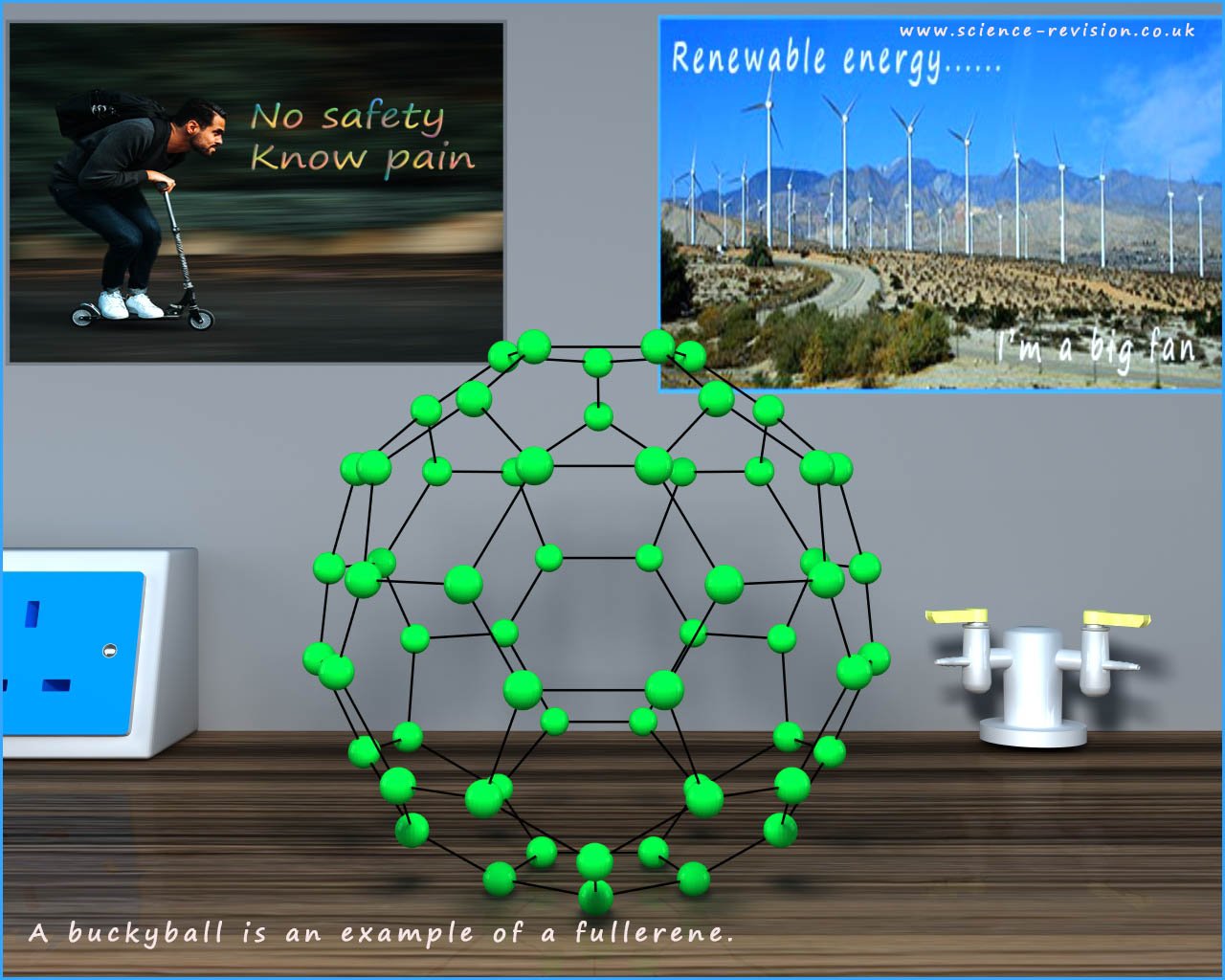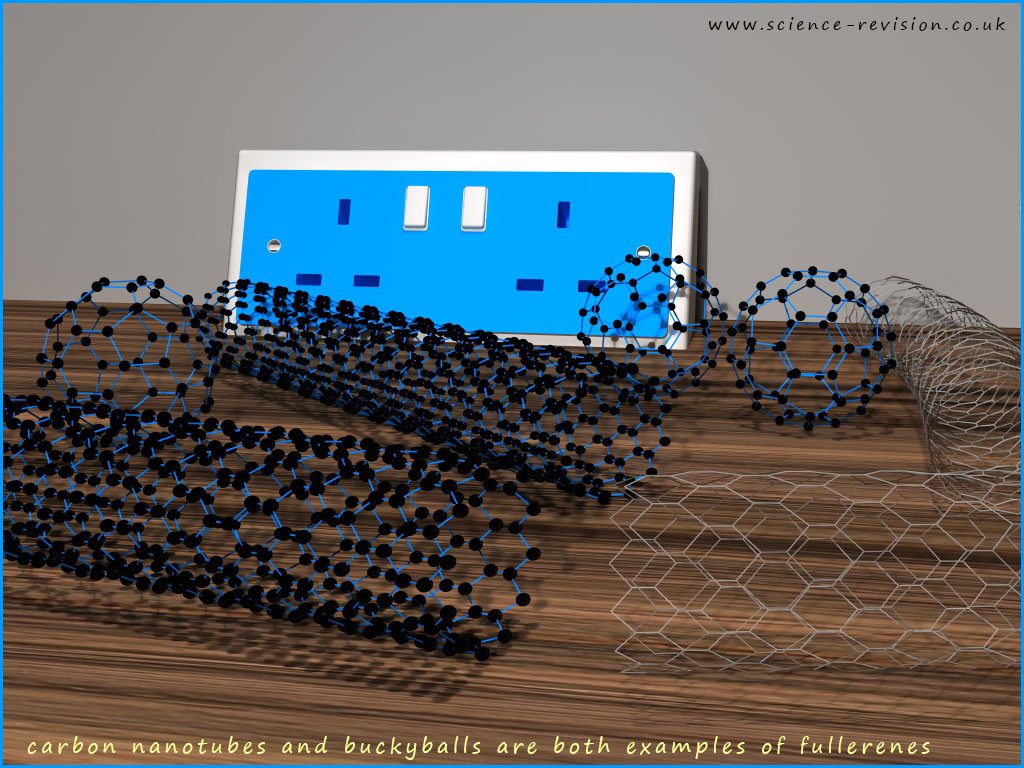

Higher and foundation tiers
 Buckminster Fuller
was an American architect, author and inventor. He was widely known for promoting geodesic dome
like structures similar to the domes at The Eden Project in Cornwall. These domes are constructed from interlocking
hexagon and a few pentagons.
Buckminster Fuller
was an American architect, author and inventor. He was widely known for promoting geodesic dome
like structures similar to the domes at The Eden Project in Cornwall. These domes are constructed from interlocking
hexagon and a few pentagons.
In the 1985 scientists discovered a new allotrope of carbon. One in which the carbon atoms are arranged in a "football"
like structure or in structures consisting of hollow cages or spheres and
tubes. These spheres and
tube shaped molecules are
called Fullerenes after Buckminster Fuller.
Fullerene molecules
are often shaped like hollow spheres or
footballs, or long thin tubes or even ellipsoid (squashed or flattened spheres).
The sizes of these spheres and tubes
can vary considerably.
The first fullerene molecule discovered consisted of 60 carbon atoms (C60) all of which are covalently bonded together into a football type structure composed of hexagons and pentagons (see the image below). This football shaped molecule was named buckminsterfullerene after the American architect Buckminster Fuller. These ball like structures are often referred to as buckyballs. These buckyballs belong to a family called the fullerenes. These fullerene molecules as mentioned above consist of hollow football spheres or tubes of carbon atoms, sometimes the spheres are distorted into capsule like structures. The image below shows the typical structure of a buckyball or fullerene molecule.

Imagine taking a layer of graphene and folding it to form a hollow cylinder, well carbon nanotubes are open cylinders of carbon atoms arranged in hexagons. These nanotubes have diameters measured in nanometres (1 nanometre is one billionth of a metre!); they are 10 000 times smaller than the width of a human hair. They may be small but these nanotubes have incredible tensile strength, many times that of steel and they are good electrical conductors. Each carbon atom within the carbon nanotubes only forms three covalent bonds leaving one free delocalised electron, much like that found in another allotrope of carbon, namely graphite. These carbon nanotubes have many new and exciting possible uses including for example: uses as artificial muscle fibres in surgery and drug delivery devices in medicine and dentistry as well as uses in many composite materials.

 Buckminsterfullerene, C60 was the first buckyball
to be discovered in 1985. However many more of these football
like cage structured molecules have since been discovered, including C70, C72, C76, C78 and
many more including a C100 molecule and a small cage
consisting of only 20 carbon atoms (C20). One of the
main areas of application for these buckyballs is in the field of medicine. There is promise that the cage like structure of
buckyballs could be used
to deliver drug molecules directly to cancer cells and help reduce
the toxic effects of the chemotherapy drugs which are usually used to treat cancers, unfortunately these drugs also have negative effects on healthy body
cells as well as cancer cells.
Buckminsterfullerene, C60 was the first buckyball
to be discovered in 1985. However many more of these football
like cage structured molecules have since been discovered, including C70, C72, C76, C78 and
many more including a C100 molecule and a small cage
consisting of only 20 carbon atoms (C20). One of the
main areas of application for these buckyballs is in the field of medicine. There is promise that the cage like structure of
buckyballs could be used
to deliver drug molecules directly to cancer cells and help reduce
the toxic effects of the chemotherapy drugs which are usually used to treat cancers, unfortunately these drugs also have negative effects on healthy body
cells as well as cancer cells.
Other medical uses include the use of buckyballs as anti-viral and anti-inflammatory agents inside the human body. There is some evidence that buckyballs and variants of them can act as anti-viral and anti-inflammatory agents, for example there is on-going research into the use of buckyballs in the fight against the HIV virus, which produces AIDS in humans and in the treatment of multiple sclerosis where the use of buckyballs appear to act as anti-inflammatory and antioxidant agents in the body.
Other possible uses of buckyballs and other
fullerenes
include their use in solar cells, polymers and as lubricants.
